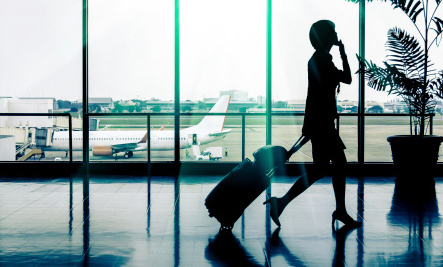Here are some tips and techniques to help you enjoy a healthy and relaxed flight.
Inflight Aerobics
It is easy to stiffen up during a long flight. Here are few simple stretching exercises to help loosen muscle and joints. You can perform them in your seat, but make sure it is in the upright position. Remember to respect the airspace of other customers. Breathe normally, and do not overstretch. Repeat the program at intervals of, say, two hours.
- Neck Exercise: Move your head slowly towards your right shoulder and hold. Then towards your left shoulder and hold. Move your chin slowly down towards your chest. Hold and relax. Repeat three times.
- Arms: Starting with your arms outstretched, flex at he elbow and bring them slowly into your chest. Extend them again. Repeat five times.
- Shoulders: Hunch up your shoulders, hold and slowly relax. Repeat five times.
- Hands: Grip the edge of your armrest with your hands, hold to a count of five, then relax. Repeat 10 times.
- Abdomen: Starting from a fully upright position, slide your hands down your legs as far as you can. Straighten up gradually. Repeat three times. Cross your arms across your chest
- Legs: Starting with your feet on the floor, bring your legs slowly up towards your chest, as far as you can. Relax them slowly, Repeat three times.
- Feet: Placing both feet on the floor, point your toes upwards as high as they will go. Point them downwards. Repeat this in a continuous movement five times.
Motion Sickness
Fortunately, most modern jets fly at relatively high altitudes and so avoid major turbulence. Which means motion sickness is increasing rare. But if you are especially prone to it, there are one or two things you can do.
The evening before you fly, it is common sense to have a quiet night in-stay off the spicy food and booze. Avoid alcohol the day you fly. When inflight, eat lightly and drink lots of fluids to prevent dehydration. If you start to feel nauseous, try to keep your head still. Simply drop your seat back and close your eyes. If such simple measures fail, there are a number of anti-sickness tablets on the market. Many contain the drugs Hyoscine (such as Kwells and Joyrides). They are usually taken half an hour before a flight and four to six hourly thereafter, but read the label for specific instructions. Antihistamines such as Avomine are an alternative.
Stress of Flying
Some of us get a little nervous when we fly, but there are relaxation techniques you can practice that are designed to relieve stress. Put your seat in the recline position. Close your eyes.
Controlled Breathing
Breathe in steadily, in a controlled fashion, as you count slowly to three. Practice for 10 to 15 minutes.
Biofeedback
Alternatively, picture yourself in a relaxed situation, perhaps on a tropical beach. You may even be flying there on vacation! Concentrate on each part of your body in turn. Feel it gradually relax. Feet, legs, thighs, tummy, chest and so on. Over several minutes, you should reduce your pulse and breathing rates and gradually tension will drain away.
Cabin Pressure Changes
Minor pressure adjustments occur within the aircraft during take off and landing – pressure falls and rises respectively. Customers notice changes in the form of ‘blocked’ ears. To avoid discomfort, you need to equalize the pressure in your middle ear. Try that well known measure, sucking on boiled sweets. Simple but often effective. Alternatively, perform the so – called Valsalva Manoeuvre – pinch your nose and blow, which ‘pops’ your ears. Incidentally, if you a suspected ear infection you should see a doctor before you fly as pressure changes can make the condition worse.
Food and Drinks
Another cabin pressure effect is, to put it delicately, ‘gas production’. As cabin pressure falls, the air in the intestine expands and causes mild bloating and discomfort. Always eat and drink in moderation. Heavy meals can lead to indigestion during a long flight. Keep fully hydrated at all times with lots of clear fluids – good old ‘sky juice’ cannot be bettered!
Jet Lag
When you travel across time zones, your biological clock becomes desynchronized, which causes jet lag. Jet lag is hard to avoid, but one tip is to get some shut-eye during the flight – dim the lights and drop your seat back. The old culprit, alcohol, upsets sleep patterns, so try not to drink too much.
Once you land, adopt local time immediately. If possible, avoid any commitments in the first couple of days – admittedly not always easy if you are on a business trip.
Pre-Existing Medical Conditions
Asthma and Chest Diseases
Well controlled asthma should be no bar to flying. Make sure you are well stocked with your usual inhalers and avoid anything that may trigger an attack. If you are wheezy before your flight, seek medical advice and treatment, then a final medical OK to board.
Other chest conditions such as chronic bronchitis and emphysema can cause inflight problems when the oxygen pressure drops a little as the aircraft take off. If you are breathless at home, even at rest, you may not be fit to fly. Similarly, if you cannot manage a 50-meter walk without breathing difficulty. If in doubt, get a formal medical evaluation from a specialist chest physician.
Heart Disease
As a general guide, people with heart disease who are able to walk up a dozen stairs without problems, should be very cautions – they are twice as likely to suffer an attack in the air as on the ground. If you recently had a heart attack (myocardial infarction), you are usually advised not to fly. Well-controlled blood pressure (hypertension) should create no problems for the air traveler.
Diabetes
People with diabetes are often confused by long-haul travel across time zones – when should they eat, when should they take their diabetic medication or insulin? The standard advice is to stay on home time throughout the journey. Eat breakfast and take an insulin shot in the middle of the night if necessary – meals should be arranged with the airline before departure. Only when they have landed, should they readjust to local times. They should make sure they have their medication in their hand luggage (not locked in the hold!) and have a letter on hand outlining their condition and medication, in case they get into difficulties.
Pregnancy
Pregnancy in itself is no bar to flying. Most airlines do not allow flight after 35 weeks. And pregnant women should always check with the immigration authorities at their destination, to make sure they are allowed to enter the country.
Miscellaneous Conditions
A minimum of three weeks is recommended for anyone intending to fly after a recent stroke. People with epilepsy are perfectly able to fly. But if prone to regular fits, they should increase their medication on the advice of their doctor and tail it down upon landing at their destination. People with severe anaemia (blood count or hemoglobin less than 7.5g/dl) are usually advised not to fly.
Deep Vein Thrombosis (DVT)
DVT is a blood clot that forms in the deep veins within the calf and leg muscles. It is usually a spontaneous condition that occurs in people especially at risk, such as those will heart disease of the elderly. However, periods of prolonged leg immobility can trigger it very occasionally. Warning signs are pain and tenderness in the leg muscles, redness and swelling of the skin. If the blood clot moves to the lung (a pulmonary embolus), breathing difficulties can occur. If you experience any of these symptoms, let one of our cabin staff know immediately or, if you have already left the aircraft, seek medical attention right away.
While flying us, we advice that you keep exercising those leg muscles. If practical, take regular walks about the cabin, except when the fasten seat belt sign is displayed. While seated, perform a few simple exercises as shown in the Healthy Air Travel chart.
Alcohol also increases the risk of developing such a condition. We would advise you to drink more water, which not only keeps you hydrated, but also maintains your physical well-being.





